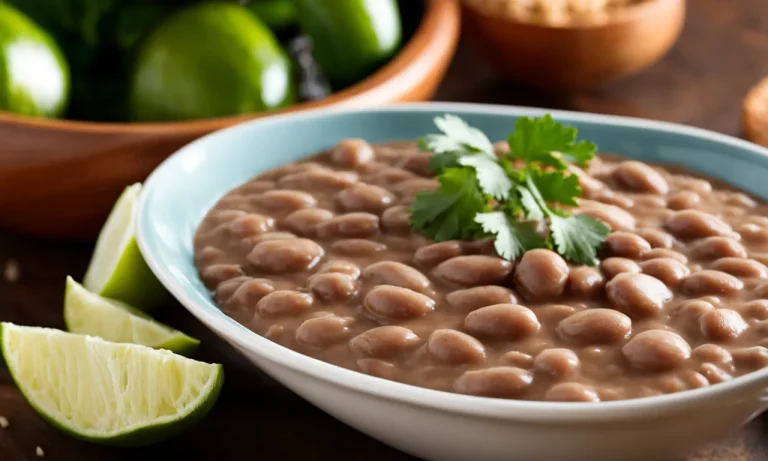Cooking oils are essential ingredients in almost every commercial kitchen. But with so many options on the market, what oil do restaurants actually use for frying, sautéing, baking, and more? If you’re curious about the types of oils chefs rely on, you’ve come to the right place.
If you’re short on time, here’s a quick answer: Restaurants typically use high-heat oils like peanut, canola, vegetable, soybean, or blended oils for frying and sautéing. For baking and dressing, they may use olive, avocado, or nut oils.
The specific oil depends on cuisine, cost, nutritional profile, and smoke point.
Oils for High-Heat Cooking
Peanut Oil
Peanut oil is a popular choice among restaurants for high-heat cooking due to its high smoking point. With a smoking point of around 450°F (232°C), peanut oil can withstand the high temperatures required for deep-frying and stir-frying.
Its mild flavor and ability to enhance the taste of fried foods make it a favorite among chefs. Additionally, peanut oil is low in saturated fat and cholesterol, making it a healthier option.
Canola Oil
Canola oil is another commonly used oil in restaurants for high-heat cooking. With a smoking point of approximately 400°F (204°C), canola oil is versatile and can be used for sautéing, frying, and baking. It has a neutral taste, allowing the flavors of the food to shine through.
Canola oil is also low in saturated fat and contains omega-3 fatty acids, which are beneficial for heart health.
Vegetable Oil
Vegetable oil is a generic term used to describe oils that are derived from various plant sources such as soybeans, corn, or sunflower seeds. It is a cost-effective option for restaurants and has a high smoking point, typically around 400°F (204°C).
Vegetable oil is often used for deep-frying, pan-frying, and baking. However, it is important to note that the composition of vegetable oil can vary depending on the blend, so it is essential to check the label for specific information.
Soybean Oil
Soybean oil is commonly used for high-heat cooking in restaurants. It has a smoking point of approximately 450°F (232°C), making it suitable for deep-frying and stir-frying. Soybean oil is versatile and can be used for various cooking methods.
It is low in saturated fat and contains polyunsaturated fats, which are beneficial for heart health. Additionally, soybean oil is a good source of vitamin E.
Blended Oils
Many restaurants use blended oils, which are a combination of different types of oils. These blends are often created to achieve a specific flavor profile or enhance the stability and smoking point of the oil. Blended oils can be a combination of oils like canola, soybean, and vegetable oil.
They offer the advantages of each oil while minimizing their drawbacks. Blended oils are commonly used for high-heat cooking methods such as frying and sautéing, providing a balance of flavor and performance.
When it comes to high-heat cooking, restaurants have a range of oil options to choose from. Peanut oil, canola oil, vegetable oil, soybean oil, and blended oils are all popular choices due to their high smoking points and versatility in various cooking methods.
It’s important for restaurants to consider factors such as taste, health benefits, and cost when selecting the right oil for their cooking needs.
Oils for Low to Medium-Heat Cooking
When it comes to low to medium-heat cooking, there are several types of oils that are commonly used in restaurants. These oils have a higher smoke point, which means they can withstand the heat without breaking down and releasing harmful compounds.
Olive Oil
Olive oil is a staple in many restaurant kitchens, thanks to its versatility and health benefits. It is commonly used for sautéing, roasting, and even in salad dressings. Extra virgin olive oil, with its rich flavor and low acidity, is often preferred for drizzling on finished dishes.
According to Olive Oil Times, extra virgin olive oil has a smoke point of around 375°F (190°C), making it suitable for most low to medium-heat cooking methods. It also contains heart-healthy monounsaturated fats and antioxidants.
Avocado Oil
Avocado oil is gaining popularity in the culinary world, thanks to its mild flavor and high smoke point. It is extracted from the flesh of ripe avocados and is known for its health benefits, including being rich in monounsaturated fats and vitamin E.
With a smoke point of around 520°F (270°C), avocado oil is ideal for sautéing, frying, and baking at medium heat. It can also be used in salad dressings and marinades.
Nut Oils
Nut oils, such as walnut oil, almond oil, and hazelnut oil, are often used for their distinct flavors and nutritional benefits. These oils are typically cold-pressed from nuts and have a rich, nutty taste.
While nut oils have lower smoke points compared to olive oil and avocado oil, they can still be used for low to medium-heat cooking. For example, walnut oil has a smoke point of around 400°F (204°C), making it suitable for light sautéing and salad dressings.
Pro tip: When using nut oils for cooking, it’s best to start with low heat and monitor the temperature closely to avoid overheating and damaging the delicate flavors.
Key Factors in Choosing Cooking Oils
Cuisine Style
When it comes to selecting a cooking oil for a restaurant, the cuisine style plays a crucial role. Different cuisines require different oils to bring out the authentic flavors. For example, in Mediterranean cuisine, olive oil is commonly used for its rich and fruity taste, while in Asian cuisine, soybean or peanut oil is preferred for its high smoke point and neutral flavor.
It’s important for restaurants to consider the specific requirements of their cuisine style when choosing a cooking oil.
Smoke Point
The smoke point of an oil is another important factor to consider. The smoke point is the temperature at which an oil starts to smoke and break down, causing off-flavors and potentially harmful compounds. Different cooking methods require oils with different smoke points.
For high-heat cooking methods like frying or stir-frying, oils with high smoke points, such as canola or grapeseed oil, are ideal. On the other hand, oils with lower smoke points, like extra virgin olive oil, are better suited for low-heat cooking methods like sautéing or drizzling over finished dishes.
Cost
The cost of cooking oils can vary significantly depending on factors such as the source, quality, and brand. While high-quality oils like extra virgin olive oil or avocado oil may be more expensive, they can add a unique flavor and health benefits to dishes.
However, for restaurants with a tight budget, more affordable options like vegetable oil or canola oil can still provide satisfactory results without breaking the bank. It’s essential for restaurants to strike a balance between cost and quality when selecting cooking oils.
Nutritional Profile
The nutritional profile of cooking oils is an important consideration, especially for health-conscious restaurants. Some oils, like coconut oil or ghee, have higher saturated fat content, while others, like olive oil or avocado oil, are rich in monounsaturated fats, which are considered heart-healthy.
Additionally, some oils contain essential fatty acids, vitamins, and antioxidants. Restaurants should choose oils that align with their customers’ dietary preferences and health goals. It’s always a good idea to provide options that cater to a range of nutritional needs.
Ultimately, the choice of cooking oil for restaurants depends on a variety of factors, including cuisine style, smoke point, cost, and nutritional profile. By carefully considering these factors, restaurants can ensure that they are using the most suitable oil for their dishes, enhancing flavors, and meeting the needs of their customers.
How Restaurants Source and Store Oil
Purchasing High-Quality Oils
When it comes to sourcing cooking oils, restaurants prioritize quality and taste. They understand that the type of oil they use can greatly impact the flavor and texture of their dishes. Many restaurants opt for oils that are known for their neutral taste and high smoke point, such as canola or vegetable oil.
These oils are versatile and can be used for various cooking methods, including frying, sautéing, and baking.
Restaurants often rely on trusted suppliers to provide them with high-quality oils. These suppliers ensure that the oils meet industry standards and are free from any contaminants. Some restaurants even choose to use organic or specialty oils, such as extra virgin olive oil or avocado oil, to cater to health-conscious customers or to add a unique touch to their dishes.
It’s important for restaurants to establish a good relationship with their oil suppliers to ensure consistent quality and timely deliveries. This allows them to maintain the standards they have set for their culinary creations.
Storing Oils Properly
Proper storage of cooking oils is crucial to maintain their freshness and quality. Restaurants typically store their oils in cool, dark places away from direct sunlight and heat sources. This helps to prevent oxidation and prolongs the shelf life of the oil.
Many restaurants use stainless steel containers or food-grade plastic containers to store their oils. These containers are non-reactive and do not affect the taste or quality of the oil. It’s important to label the containers with the type of oil and the date of purchase to ensure proper rotation and avoid using expired oils.
In addition to storage containers, some restaurants also invest in oil filtration systems. These systems help remove impurities and extend the usability of the oil. Regularly filtering the oil can improve the taste of the food and reduce oil wastage.
Disposing of Used Oil Responsibly
Restaurants have a responsibility to dispose of used cooking oil in an environmentally friendly manner. Improper disposal can cause pollution and harm the ecosystem. Many restaurants partner with recycling companies that specialize in collecting and recycling used oil.
Recycling used cooking oil has several benefits. It can be converted into biodiesel, a renewable energy source that reduces greenhouse gas emissions. Additionally, some recycling companies offer incentives or rebates to restaurants for their used oil, creating a win-win situation for both parties.
Restaurants should also follow local regulations and guidelines when it comes to disposing of used oil. This ensures that they are compliant with environmental laws and are doing their part to protect the planet.
For more information on sustainable practices in the restaurant industry, you can visit www.sustainablerestaurantgroup.com.
Conclusion
With so many options on the market, restaurants take great care in choosing the right oils for cooking, baking, frying, and more. The cuisine style, smoke point, cost, and nutritional profile all play a role.
While high-heat peanut, canola, vegetable, soybean, and blended oils are common in commercial kitchens, olive, avocado, and nut oils also have their place for lower-temperature cooking. Following proper purchasing, storage, and disposal practices also helps restaurants get the most out of these versatile ingredients.






